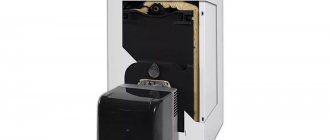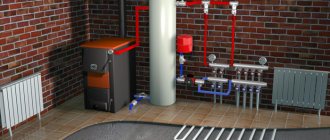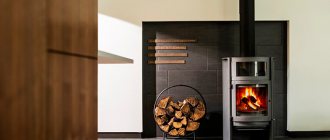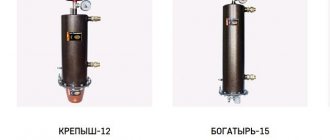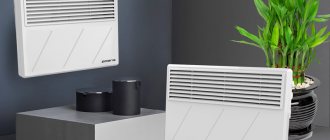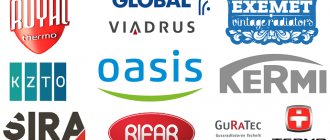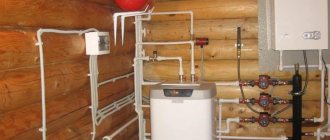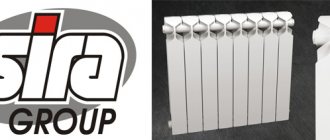To make your home comfortable in our latitudes in winter, heating needs to be installed inside. And the more funds the owner has, the better quality the heating system can be installed.
And for a budget option, panel heating is suitable. In this case, the room is heated from heating panels built into the wall or floor .
At the moment there are several types of them: water, electric and infrared.
Thermal panels: what are they?
A comfortable room temperature is not created by heating the surrounding air. First, the walls , and from them the heat is transferred into the room.
It is necessary to regulate the average temperature of the heated surface depending on where it is located. For example, ceiling panels are subjected to the maximum heating, while the floor is subject to the least heating - up to 40 °C .
The heating device of SIP panels consists of two steel sheets , fastened by welding, with pipes with coolant between them (this is the case if the role of the latter is played by water).
When electricity is used, the heating elements are concreted into the thickness of the wall. To achieve greater effect, the panels must be placed under the window. In this case, the falling cold flow is neutralized.
Classification of IR heaters
Infrared heaters can be divided into several types depending on the energy carrier used to transmit infrared waves:
- Gas. The source of energy in such heaters is a mixture of gas and air, burned on the surface of heat-resistant perforated plates located inside. Due to their high power, gas IR heaters are rarely used in everyday life. Most often they are used in production workshops or on the street.
- Electric (heating element, spiral). Heaters of this type can be considered universal, since they are applicable both in industrial conditions and at home. The “heart” of an electric infrared heater is a tubular electric heater (TEN) or a special open spiral. The design feature of the device is a reflector (mirror) that reflects infrared waves in the desired direction.
- Film. They also run on electricity. The operating principle is to heat carbon elements. This is an ideal option for local heating of rooms in a residential building.
- Diesel. They are most often used to heat rooms with weak wiring, such as a garage. It is worth noting that, unlike conventional diesel heating devices, diesel IR panels do not require smoke removal.
Advantages and disadvantages
Advantages of panel heating:
- The heating elements of the panels located in the wall can reduce heating costs by up to 20%. The only thing required is that the room is well ventilated. If air exchange is carried out through filters, this is not economical. Since the ventilation intensity is extremely low.
- The location of coolants inside the walls allows you to reduce the optimal temperature in the house by several degrees. For example, with convective heating a person feels comfortable when the room temperature is at least 18-20 °C ; with panel heating, 15 °C is required.
- Saving usable space.
- Ensures uniform heating of the room.
- Even at low temperatures there is no effect of “cold” walls.
Disadvantages of panel radiant heating:
- This type of heating shows a slow response to the fact that external loads have already changed.
- Due to the location of the heating element in the thickness of the walls, it is difficult to repair. You'll have to dismantle the wall and floor.
- Requires a specific location.
- Panels located in the floor are less efficient, since the maximum heating temperature is limited to 30, rarely 40 °C.
Types of panel heating for home
There are the following types of panel heating.
Water system
The most popular scheme, due to the fact that it successfully combines low price and high efficiency. In urban dwellings, such a panel system is installed by default. In individual houses it is installed only if it is intended for year-round use.
It consists of metal pipes of small diameter located in the thickness of the walls, through which water or other technical liquid is released.
Operating principle: water, heating up in the boiler, moves through pipes that heat the wall, and it heats the air in the room.
- the home heats up in a quarter of an hour;
- cheapness;
- ease of installation of panels.
- Do not use any liquid other than water;
- cools quickly.
The convection process is quite slow, so it is necessary to place the radiator as low as possible, otherwise the floor of the room will be cool.
Electrical panels
Operating principle: the device creates a stream of infrared rays having a certain wavelength. They heat solids, not air . As a result, at a temperature of about 18 °C, a person feels quite comfortable.
Important! All solid bodies in the room, exposed to the rays and heating up, become sources of secondary radiation. Therefore, it seems that warmth surrounds you from all sides.
IR panels are qualified according to their location:
- Ceiling ones are considered the most effective , since in this case the entire area of the room is heated. And they can heat up to 900 °C - these are short-wave devices.
- Wall panels. It is recommended to place them as low as possible - the effect will be greater. Maximum heating up to 400 °C.
- You can know that the device is working within 10 minutes.
- There is no creation of convective air currents, which means dust will not move around the room.
- They do not require routine maintenance or operation monitoring.
- Externally, the panels look very attractive .
- Save space thanks to compact dimensions.
- Wide range of use.
Attention! Among the minuses, it is worth noting the rapid cooling of the room and the rather high energy consumption.
Recently, heaters have begun to be mounted on plasterboard wall cladding. It's much cheaper.
Ceramic from Nikaten
The panel material is natural ceramics, due to its ability to quickly accumulate heat and slowly release it to the environment as it cools.
Monolithic metal structure with a polymer coating, onto which ceramics are hermetically attached. A flexible heat-resistant cable is laid between the body and the ceramic, serving as a heating element. On the front side of the tile, the operating temperature can reach 80 °C, on the back side - up to 90 °C.
Best options
7th place. STN 500 W
The STN 500 W IR heater opens our list of the best panel-shaped heating devices. The first thing worth noting about this model is that there are two options for its installation. This heater can be placed both on the wall and on the floor, and in the latter case you can put the panel on the wheels that come with it.
This model can easily heat small (up to 10 m2) rooms in a house, apartment or office.
This model also has one feature, which is a double heating method. In addition to the infrared spectrum, it can work as a convector.
Pros:
- optimal heating;
- does not dehumidify the air in the room;
- energy efficient;
- protection from moisture and overheating;
- certification was carried out in the Russian Federation and the EU;
- quality guarantee up to 5 years.
Minuses:
- oil radiators, which are not much inferior to it, are cheaper.
STN 500 W
6th place. BISON IKO-K3-1000
In sixth place in our rating is a domestic model from the ZUBR company called IKO-K3-1000. The presence of a heating element in its design and a power of 1000 W loudly declare the advantages of this model.
The reliability and durability of domestic devices is a separate matter. The very name of the ZUBR company already indicates that the device will serve you faithfully for a very long time. The 5-year warranty is a clear confirmation of this.
The combination of aluminum and other metals with an anodized coating is another secret to the good heating of rooms with this heater.
Remember! The thermostat is not included in the package. It must be purchased separately.
Mounting to the ceiling is easy and quick, and even an inexperienced person can handle it.
Pros:
- high-quality case;
- high power;
- ease of operation;
- energy efficiency;
- does not create noise during operation.
Minuses:
- The thermostat and power cord must be taken separately.
BISON IKO-K3-1000
5th place. Almac IK11
Do you need an IR heater, but not a simple one, but a specific color? Then you should pay attention to the fifth place in our rating - the Almac IK11 model, which is characterized by the presence of five shade options for everyone who cares about design.
In addition, this IR heater weighs little and is small in size. And at the same time, it has a power of 1000 W, which is surprising for such a small device.
Installation can only be done on the ceiling using suspended mounts.
Almac IK11, interestingly, cannot fully operate without an external thermostat, because it is not included in the kit. But there are simple and clear instructions that will explain how to connect it to this IR heater.
Pros:
- rich color range;
- easy installation;
- does not dry out the air;
- good room heating.
Minuses:
- dependence on an external thermostat;
- noisy heating element.
Almac IK11
4th place. Hyundai H-HC2-30-UI692
In fourth place in our rating is a model known for its reliability from the well-known Hyundai company - H-HC2-30-UI692. Its main advantage is considered to be a two-variant arrangement - installation is possible both on the wall and on the ceiling.
The declared power of this heater, in comparison with previous models, is simply amazing - 3000 W fit into a fairly thin body, at which the air is 30 square meters. m. room heats up quickly, and the room or small office will always be warm.
Pros:
- does not dry out the air;
- keeps a large area warm;
- high power;
- no burning smell;
- silent operation;
- two mounting options.
Minuses:
- high price;
- heavy device;
- no thermostat included.
Hyundai H-HC2-30-UI692
3rd place. Wester IH-2000
The bronze medalist of our rating is the Wester IH-2000 model. Its power is 2000 W, which is enough to heat a room of 20 square meters. m. fits perfectly.
Mounting on the ceiling allows you to keep the room warm without taking up space. Another advantage of this panel is the ability to hide all wires and communications, exposing only the IR panel itself. The mounts themselves allow you to withstand the heavy weight of the device.
The absence of rotating elements allows for virtually silent operation and low electricity consumption, which also adds advantages in the eyes of a potential buyer.
Pros:
- ceiling mounting;
- stylish design;
- rapid heating of the room;
- ease of use;
- affordable price;
- energy efficiency at a high level.
Minuses:
- additional installation work will still be required;
- small number of power settings.
Wester IH-2000
2nd place. Ballu BIH-S2-0.3
The IR panel from Ballu takes the silver place in our top. BIH-S2-0.3 is considered the smallest IR heater, which imposed restrictions on the power of the device - 300 W, which is enough to heat small rooms.
The ceiling mounting form with protection from dust and moisture allows you to think about connecting the device in small rooms and offices. Thermal insulating material provides good heating of the premises. And the ability to install several of these heaters at a time improves the quality of heating.
Pros:
- versatility and compactness in design;
- easy installation;
- does not make noise during operation;
- like a “warm floor”, only the installation is on the ceiling.
Minuses:
- heats only small rooms;
- It's easy to get the case dirty.
Ballu BIH-S2-0.3
Choose wall or floor
Even at the design stage, it is necessary to resolve the issue of installation location. For example, in America it is customary to place panels in the floor .
From a construction point of view, this is a very convenient solution, since it is enough to install heating in them when pouring the floors.
It will take longer to heat up, because when the panels are placed on the floor, the maximum temperature is 30 °C. If you heat it higher, it will burn your feet.
In Europe, it is common to place thermal panels on the ceiling . High temperatures up to 50 °C allow you to heat the room faster. But from an economic point of view, such an arrangement will lead to an increase in its price.
Installation
Installation of heating panels is simple. First you need to decide on a place. This is done on the cold (outer) wall of the room, near balcony doors, under windows and near beds. It is necessary to calculate the total power so that approximately 50-100 watts per square.
Power calculation
Before buying heaters for your home, you need to decide on their quantity. This can be done using a simplified formula. If infrared ceramic panels will serve as additional heat sources, you need about 25 W per 1 m². If the main ones are 50 W per 1 m².
But these are very approximate figures. Accurate calculations are made based on the height of the ceilings, the thickness of the walls, the tightness of the windows, etc. It is necessary to take into account all the factors affecting heat loss, and it is advisable to invite specialists for this. You will have to pay for their services, but in the end these costs will be worth it.
It is also important not to make a mistake with the place. Heaters are usually installed under windows to prevent cold air from coming in. Avoid installation in corners and niches, as poor air circulation reduces the efficiency of the device.
The predicted service life of the ceramic infrared heater is 30 years
Summarize
Modern heating panels are an excellent alternative to traditional radiators , surpassing them in many ways. They can be located in any facility: residential, warehouse, public, educational, medical or preschool.
Traditionally, the operation of heating systems is based on increasing the air temperature in the room, through which surrounding objects are heated. The operating principle of infrared panels is different: the energy they distribute resembles natural radiation from the sun, flame or fireplace.
How infrared panels work
It is no secret that the heated area is much larger than the surface of the heating devices. The high rate of room heating with infrared heating panels is explained by the fact that the energy they emit is much better absorbed by the surface of objects. Compared to conventional heaters, in this case the temperature in the room rises 4 times faster.
It has been noticed that radiant heat is especially well accumulated by furniture, which, after accumulating energy, itself turns into a heating source. To avoid heat leakage to the street, it is not recommended to direct the rays of infrared heating panels onto the surface of walls, ceilings, doors and windows. Another useful quality of devices of this type is that they do not burn oxygen.
It is for this reason that they are used to maintain optimal temperature in such rooms:
- Apartments.
- Private houses.
- Trading platforms.
- Factory workshops with high ceilings.
- Warehouse premises.
- Open areas.
Information on infrared heating
Infrared thermal panels are direct heaters. The technology is based on the use of light waves from the region below the visible region of red light (long infrared waves IR-C*). This heat can be compared to the sun's rays. Infrared radiation is completely natural and safe. Moreover, it works well for consumers (used in maternity hospitals for many years). The most visible source of infrared heat wave is, of course, the Sun. Using room heating based on infrared heating panels, you bring a small solar home! The waves emitted by the panels reach the body without heating the air, creating a feeling of soothing warmth and comfort.
Infrared radiation waves are divided into three types: short wavelengths near visible light IR-A (>700°C), medium wavelengths IR-B (about 250–700°C) and long wavelengths IR-C (<250°C). A person is able to sense infrared heat waves when the temperature of a given object is above 22°C, but, of course, the higher the surface temperature, the greater the susceptibility of the heat wave.
The advantages of such heating
When compared with conventional heating systems and household heating appliances, infrared heating panels have a number of advantages:
- The temperature in a heated room can be raised to +50 degrees.
- Ability to maintain comfortable temperature and humidity conditions.
- During operation of electric thermal panels, there are no convection air currents that raise dust.
Devices of this type can perform not only the role of auxiliary heating, complementing traditional radiators. They are often used as the main heating devices. To determine the most suitable heating mode for a home, the originally installed heating system, the materials used to build the house, the characteristics of the climate zone, etc. are taken into account.
When choosing the optimal model of infrared heating panels, it is recommended to consider the following points:
- The device is usually equipped with a special thermostat, which makes it easier to maintain optimal temperature conditions and the level of electrical energy consumption.
- The difference between the air temperature near the ceiling and the floor can be reduced to a minimum.
- Such heating does not require bulky piping, radiators and boilers.
- The infrared heating panel can be installed anywhere (on the wall, ceiling), without losing its level of efficiency.
- The heater allows for laying tiles on top, installing plasterboard structures and gluing wallpaper.
- These devices can be used for 50 years or more, in conditions of increased fire and environmental safety.
What are the types of infrared heating panels?
All products of this type are divided into two large groups:
- Mounted . Most often they are equipped with a colored metal case, heated by an infrared emitter. The device is powered by a regular outlet. Both separate and mounted types of installation are used.
- Built-in . The basis of such a panel is a plasterboard board covered with a layer of insulation. The IR emitter located on top is made in the form of a carbon conductive wire protected by a polymer sheath. The panel is powered from a standard 220 V network.
As for designer wall heating panels, they can have different colors and sizes, and are usually allocated in a separate line. A slab in the form of a plinth looks very original: it can be used to decorate the perimeter of a heated room. When finishing walls with plasterboard, wall heating can serve as the main one. In those dwellings where the main heating source is already available (solid or liquid fuel boiler), heating panels play a secondary role.
It should also be said about the weaknesses of these devices:
- Although the feeling of warmth from the rays comes almost instantly, infrared devices act mainly locally: one area of the room will be heated, but the other will not.
- Due to the uneven effect of heat on the human body, he may experience health problems - headaches, fatigue, chills.
- Since during operation of the IR panel it is not the air that heats up, but the surrounding objects, a plastic smell may appear in the room due to the heating of plastic surfaces.
- Despite the high power of such heaters (about 1.2 kW), their radius of action is usually limited to a space of 8 m 2.
- Infrared radiation has a negative effect on the eyes.
Recommendations for using infrared heating films
The main feature of such heating is the absence of energy losses during transportation from the source to the radiating surface. This film can be laid on any surface, including floors, walls or ceilings. In the latter case, it occupies approximately 2/3 of the total area, which allows for good heating uniformity. If desired, the film can be further decorated. It is important to remember that combining panel heaters with a stretch fabric or PVC ceiling is prohibited. It is recommended to build a plasterboard platform on top of the device. When using decorative finishing, you should avoid the presence of metal elements in it.
The main advantages of heating films are:
- Lack of communication wiring.
- The infrared panel heater is powered from the household network, without the need for an additional boiler and pipeline.
- The system will not freeze if idle at sub-zero temperatures.
- The heating film is very mobile: it can be removed at any time and attached to another place.
- The operation of such a system is very simple, and special maintenance is not required.
- The operation of the film is not accompanied by noise or combustion products.
- The circuit tolerates voltage surges well.
- If all rules are followed, infrared film can last at least 20 years.
The disadvantages of film heating usually include significant energy consumption, so it cannot be called economical.
What other types of infrared heating are there?
Ceiling infrared panels do not take up much space. They can be used in rooms with a height of more than three meters. They are distinguished by quiet operation, environmental safety and the ability to organize heating of a specific area. Panels for heating rooms are convenient to install and operate. Some cassette ceiling manufacturers complete their products with special heaters.
In addition to the significant consumption of electrical energy, ceiling heating panels have another drawback: they are not always able to maintain the overall aesthetics of the room. As for wall-mounted infrared heating panels, they are a good replacement for traditional batteries. Due to its small thickness and light weight, such heating can be installed independently.
Features of choosing an infrared heater for the ceiling
When choosing a suitable IR heater for home use, you should pay attention to several points. First, be sure to check with the seller how thick the anodizing layer is on the wave-emitting plate. If an indicator of less than 25 microns is announced, you should not count on the long-term service life of the selected model. Otherwise, you will have a reliable, efficient heating device for your home for at least ten years. Unfortunately, it is impossible to visually check the indicator, so you will have to trust the seller’s words.
Ceiling IR heater design
Secondly, also pay attention to the color of the metal from which the heating element is made. If it is black, then the model in question cannot be used to heat wet rooms, such as a bathroom/sauna. If the metal is stainless steel, then the heater can be considered universal in terms of use for rooms with different humidity levels.
Thirdly, be sure to check the thickness of the foil used for the emitter. Ideally, it should be at least 120 microns. If the indicator is less than specified, then the heater will work “idle”, heating not the room, but the ceiling.
Well, the last point: power. This indicator is also worth paying attention to, since the ability of the device to heat the rooms in your home will depend on it. Thus, devices with a power of 750 W are capable of heating a room of no more than 10 square meters. m. For more spacious rooms, you will need a more powerful device - from 1000 W.
Advice. To heat non-residential premises such as a garage or rarely used rooms, for example, rooms in a country house, an IR heater with a “modest” power of 300 W is sufficient.
At this point, perhaps, we can finish our consideration of the features, advantages and design of infrared ceiling panels for space heating. Enjoy the shopping!
Optimal installation location for electrical thermal devices
In this regard, personal preference is crucial. There is no consensus on this issue: some people like wall mounting of infrared heating panels, others prefer floor or ceiling mounting. Considering that warm air always rises, installation on walls is not so effective. If you place heating panels on the floor, the air heated with their help will evenly heat the entire room, gradually rising to the ceiling. The operation of ceiling heating panels is approximately the same: in this case, everything depends on the convenience of the location.
With the arrival of autumn, the temperature in apartments and cottages becomes not too comfortable. The central heating has not yet been started, but it is already noticeably cool outside. It is not surprising that many try to prepare in advance for this phenomenon by purchasing an effective heater. A panel heater is one of the most effective devices on this market, which appeared relatively recently, but has already achieved high popularity. The panel design is due to the fact that it allows full use of the available space. When installed, the panel takes up minimal space, can be installed on the surface of a ceiling or wall, and is characterized by an impressive area, which increases the heat transfer coefficient.
Advantages and disadvantages of IR thermal devices
Many people are wondering why infrared ceiling panels are so popular both in industry and in everyday life. In order to answer it, it is necessary to carefully analyze the advantages that this heater has:
IR heater operation
- High-quality heating. As mentioned earlier, the IR heater has a unique specificity for heating rooms, heating, first of all, the objects located in it, and not the air. At the same time, the room warms up quickly and evenly without the unpleasant possibility of drafts.
- Energy efficiency. IR heaters have incredibly high efficiency - about 90%. That is, almost all the energy generated by the device is “given” for heating. In addition, the infrared heater heats the room in an incredibly short time, which can significantly reduce energy costs.
Advice. When choosing a suitable ceiling heater, pay attention to models with thermostats that automatically turn off the device when the desired room temperature is reached.
- Environmental friendliness. Infrared heaters do not contain absolutely any toxic elements in their design, therefore, from the point of view of their safety for the human body, the device can be given 10 points out of 10.
- Safety. Unlike most heaters used in everyday life, IR heaters are absolutely safe from many points of view. For example, they are absolutely fireproof. In addition, they do not dry out the air at all and do not affect the amount of oxygen in the heated room.
- Practicality and ease of installation. The design of the IR panels is created in such a way that they are very easy to install, since all the fastenings necessary for mounting on the ceiling are built into the device body.
Advice. If you plan to install infrared ceiling panels on a suspended ceiling, take care to create a support beam or brackets directly in the “native” ceiling base.
Modern technologies
Economical panel heaters with low energy consumption are presented in several groups.
Carbon infrared models for wall installation
Heating is carried out by an internal carbon-based element. The principle of operation is based on the production of infrared radiation, due to which thermal energy is transferred. To some extent, the effect of convection also takes place; the cold air of the room comes into contact with the heated surface of the device, naturally rises upward, and constant circulation of air masses occurs. The mass of these devices is small, which simplifies installation.
An additional feature is that during operation, anions are generated, that is, negatively charged particles that improve the microclimate of the room and promote effective dust deposition.
The outer plane of the device reaches a maximum temperature of 80 degrees, that is, dust and oxygen are not burned, but you can get a burn if handled carelessly. If there are children at home, installation is carried out taking this feature into account. Modern modifications of this equipment are complemented by temperature regulators, thanks to which microclimate settings are adjusted and energy consumption is reduced. However, you can only see them on high-power devices, from a kilowatt.
Ceramic panel
Inside this device there is a ceramic heating plate, thanks to which an even distribution of thermal energy is achieved without significant heating of the surface. The peculiarity of the model is its significant thermal inertia, however, heating of the room is achieved in a fairly short time. The heat from these panels is quite soft, creating a pleasant microclimate. Some disadvantage lies in the heavy weight, which complicates installation.
Quartz panel
The base of the body is made of quartz sand, and inside there are several metal spirals. First, the contents of the panel heat up directly, it begins to accumulate heat and transfer it to the room. This feature explains the significant thermal inertia of the device; full heating occurs only after 25 minutes. However, this same feature explains that the panel will cool down gradually, and even when turned off, it will be able to heat the room.
Unfortunately, this is not the best option if there are small children in the family, because the surface heats up to 95 degrees, so you will either have to install it at an inaccessible height, or take care of a protective screen.
The increase in indoor air temperature is achieved mainly through convection, but infrared radiation also occurs. In fact, this device can be classified as an electric convector, but improvement with quartz sand has made it possible to increase inertia and reduce the surface temperature, so that dust and oxygen are not burned.
Heating patterns
The most unusual appliances for the home. In fact, they are devices with carbon elements, but the outer surface is decorated with a drawing or photograph, so they look not like utilitarian devices, but like paintings.
Classic options
More traditional devices that have been known for several decades are also produced in the form of panels:
- Modular radiator. Structurally, this device is very similar to an analogue of water heating, but is intended for autonomous use. Most often, the device operates on a “dry” principle, that is, steel rod heaters are located inside.
- Panel type convector heater. From a design point of view, this is a fairly simple device, inside of which there is a heat exchanger, and outside there is a convection chamber, which also serves as a protection and forms the overall appearance of the equipment. The operating principle is entirely based on convection. Modern modifications are quite economical and also completely safe; the heating of the body reaches a maximum of 60 degrees, that is, it is impossible to get a burn. It should be remembered that achieving the set temperature in the room using this technique will take 20-30 minutes; you should not count on instantaneous operation.
Main advantages of ceramic electric heating panels
• Ceramic electric panels can be used to heat residential, commercial and industrial premises. In addition, due to the high degree of protection from external influences, the heater can be installed in rooms with high humidity, for example in the bathroom.
• The heat emanating from this type of heater has a beneficial effect on the body, creating the healing effect of a “Russian stove”.
• One ceramic panel has an average power of 370 W and consumes no more electricity than a desktop computer. Compared to traditional heaters (convectors and fan heaters), energy savings when using a ceramic panel can reach 30 percent. And installing thermostats and a multi-tariff meter will allow you to reduce electricity costs to the lowest possible level.
Advantages of panels
Let us summarize the advantages that characterize all panel heaters, regardless of the type of heating element:
- Saving space in the room, since unused planes of walls and ceilings are used for installation;
- Stylish appearance;
- Manufacturability, energy saving;
- Easy to install;
- Possibility of further decoration and hiding under protective panels without compromising efficiency, if required by the interior of the room.
If we talk about which devices are better, then it will not be possible to give a clear answer to this question. It is necessary to consider each situation individually. For example, for a city apartment it is worth choosing an infrared option, which is optimal for constant use and demonstrates efficiency. For periodic use at the dacha or in a country house, a convector is better suited.
A few words about the types of infrared heaters
Conventionally, this type of climate control equipment is divided into three groups depending on the location: floor, wall and ceiling. The difference between all of them lies only in the installation pattern and the presence or absence of certain functions.
Floor
Instruments of this type of installation can be transported, which makes transporting it an attractive advantage when choosing a purchase. For ease of carrying, there is either a handle or a special compartment for installing a cord, and there may also be small wheels.
As a rule, such heaters have special sensors. For example, one of them saves you from overheating, the other turns off the device when it overturns. It’s interesting what thermostats or the ability to control from the remote control add.
Wall
This type of infrared heater has two places - a niche under a window or the bottom of a wall.
As a rule, they are made to look like central heating radiators, like many people already have in their house or apartment, but they are flat. Let us immediately note that they heat no worse than other types of IR heaters.
All wall-mounted options boast a thermostat and a system that protects the device from overheating. Since the wall-mounted model is heavier than the floor or hanging model, it is installed for a long time, taking into account all the nuances of the room design. During installation, you may need to decorate the device with various decorative elements, such as ornaments, stone, stucco, or simply paint it in the desired color.
Ceiling
Typically, ceiling options are made very similar to lamps, and they are quite bulky in size and quite heavy in weight. Such heaters are not entirely suitable for installation in residential premises - they are better used in non-residential premises, such as an office, garage, and various warehouses.
The advantages of this version of the IR heater are their high power, which will provide a lot of heat, the presence of a thermostat, as well as a large area coverage, which can help in heating large rooms. This heater can be controlled using a remote control, which is quite convenient.
Important! Separately, it is worth noting mixed models with mounting on the wall and ceiling or on the floor and wall. Their versatility allows you to expand the possibilities of heating the room by choosing the installation location.



